In Serbian football, FK Partizan Belgrade has emerged as a formidable force, showcasing an exceptional season in the Super Liga Srbije under the astute guidance of their manager, Igor Duljaj. The former Partizan and Shakhtar Donetsk midfielder has left an indelible mark on the team, orchestrating a significant shift in their playing style that has propelled them to the summit of the league table — a league they’ve failed to win since 2016/17, with Red Star dominating recent seasons.
Under Duljaj’s stewardship, Partizan has undergone a tactical metamorphosis, departing from the conventional norms to embrace a style that reflects the manager’s football philosophy. This transformation has not only captured the imagination of the fans but has also yielded tangible results on the pitch, allowing Partizan to assert their dominance in the Super Liga Srbije.
Currently occupying the coveted top spot in the league standings with an impressive tally of 47 points after 19 matchdays, FK Partizan finds themselves in a gripping title race, edging out perennial rivals Red Star Belgrade by a solitary point. The narrative of their outstanding season gains further depth and significance as Partizan clinched a crucial victory in the direct duel against Red Star Belgrade, securing not only three points but also a psychological advantage in the race for the championship.
As we delve into Partizan’s tactics in this analysis, it becomes evident that Duljaj’s influence extends beyond mere results. This tactical analysis in the form of a scout report aims to dissect the key elements of Partizan’s playing style, shedding light on the tactical nuances that have propelled them to the forefront of Serbian football and positioned them as serious contenders for the Super Liga Srbije crown.
Squad Planning
The current league standings that see FK Partizan Belgrade sitting comfortably at the top of the table are nothing short of surprising, especially when considering the substantial financial disparities between Partizan and their arch-rivals, Red Star Belgrade.
In terms of market value, Partizan may be positioned second in the league, but their overall team value stands at 35.150.000€—significantly less than Red Star’s impressive 71.900.000€. This glaring financial difference, with Red Star having more than double the market value of Partizan, usually translates into a distinct advantage in terms of squad depth, player quality, and overall resources.
Adding to the surprise is the fact that Partizan’s transfer expenditure, while competitive within the league, is still notably lower than Red Star’s. Partizan’s transfer expenditure of 3.750.000€ contrasts with Red Star’s 12.400.000€, underscoring the financial constraints that Partizan has had to navigate.
One of the key contributors to Partizan’s unexpected success is their impressive goal conversion rate of 9.7%, which places them in the second position in the league. Notably, this statistic reflects their efficiency in converting goal-scoring opportunities into tangible results on the field.
Comparatively, Red Star Belgrade, despite boasting a market value that is more than double that of Partizan, finds themselves trailing in the league standings. Red Star’s goal conversion rate of 9.4%, while respectable, places them in the fourth position, highlighting a relative inefficiency in front of goal when juxtaposed with Partizan.
In terms of the average age of players at Partizan, there has been a subtle yet noteworthy decrease from 27.7 in the previous season to 26.70 in the ongoing campaign. This indicates a strategic emphasis on integrating younger talents, potentially contributing to a more dynamic and agile approach.
Current situation
The change of FK Partizan Belgrade from the 2022/23 season to the current 2023/24 campaign is nothing short of extraordinary, a testament to the profound impact of manager Igor Duljaj’s strategic acumen.
In the previous season, Partizan held a respectable fourth position in the league, a solid standing but not one that echoed the heights of their historical dominance. Fast forward to the present season, and the team has undergone a seismic shift, emerging as the undisputed leaders, perched at the pinnacle of the league table. This ascent to the top spot is a clear manifestation of their overperformance, surpassing the expectations set by the preceding campaign.
While the raw numbers show a slight dip in goals scored – from 68 in the last season to 44 in the current one after 19 matches – a more nuanced examination is required. The expected goals (xGoals) metric, a measure of the quality of chances created, has also decreased from 64.55 to 44.89. This suggests a similar efficient conversion of opportunities.
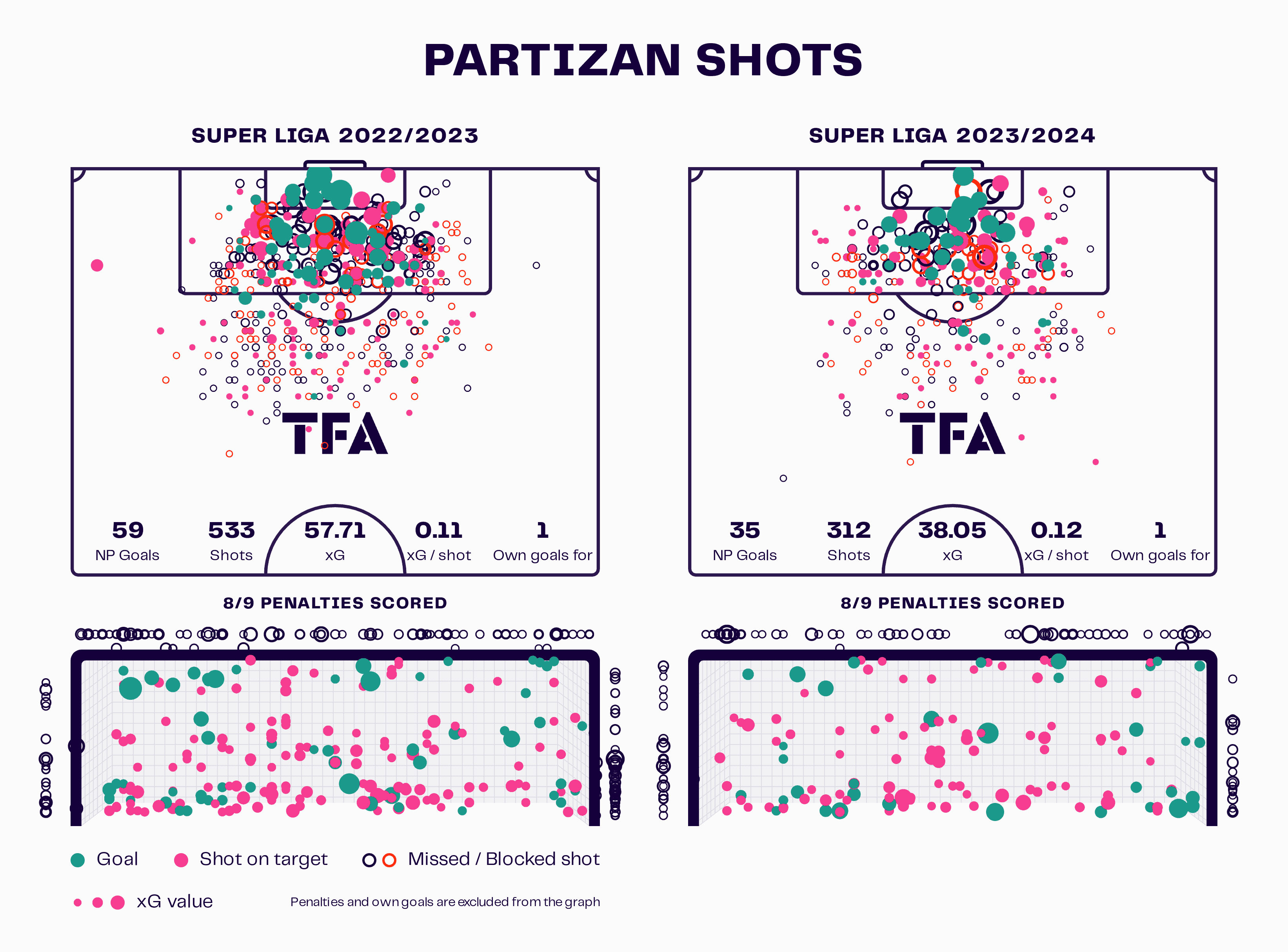
Their top transfer, Matheus Saldana, epitomised this effectiveness in front of goal. The 24-year-old Brazilian striker, acquired for a relatively modest fee of 1.300.000€ from J2 League club JEF United Chiba, has been nothing short of a revelation. Saldana’s remarkable tally of 14 goals and five assists in 18 appearances has not only justified his acquisition cost but has also seen his market value soar from 500.000€ to an impressive 5.000.000€ in half a year.
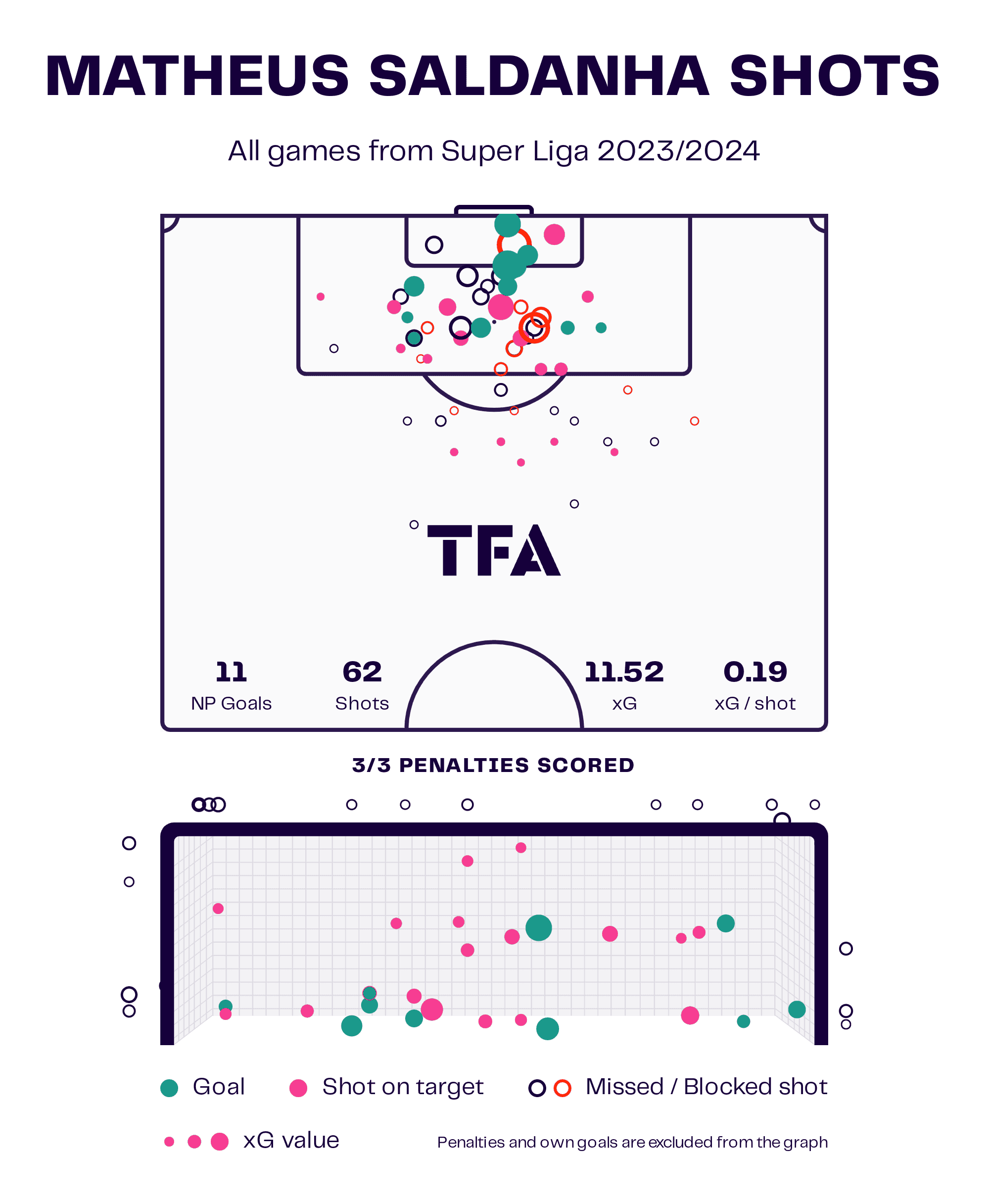
Defensively, Partizan’s transformation is even more striking. Conceding 34 goals in the previous season, the team has fortified its defensive lines, allowing only 22 goals in 19 matches in the ongoing campaign. The expected goals against (xGoals against) metric further bolsters this defensive improvement, dropping from 28.39 to 22.62. The implication is a more resilient and organised defence that adeptly limits high-quality opposition chances.
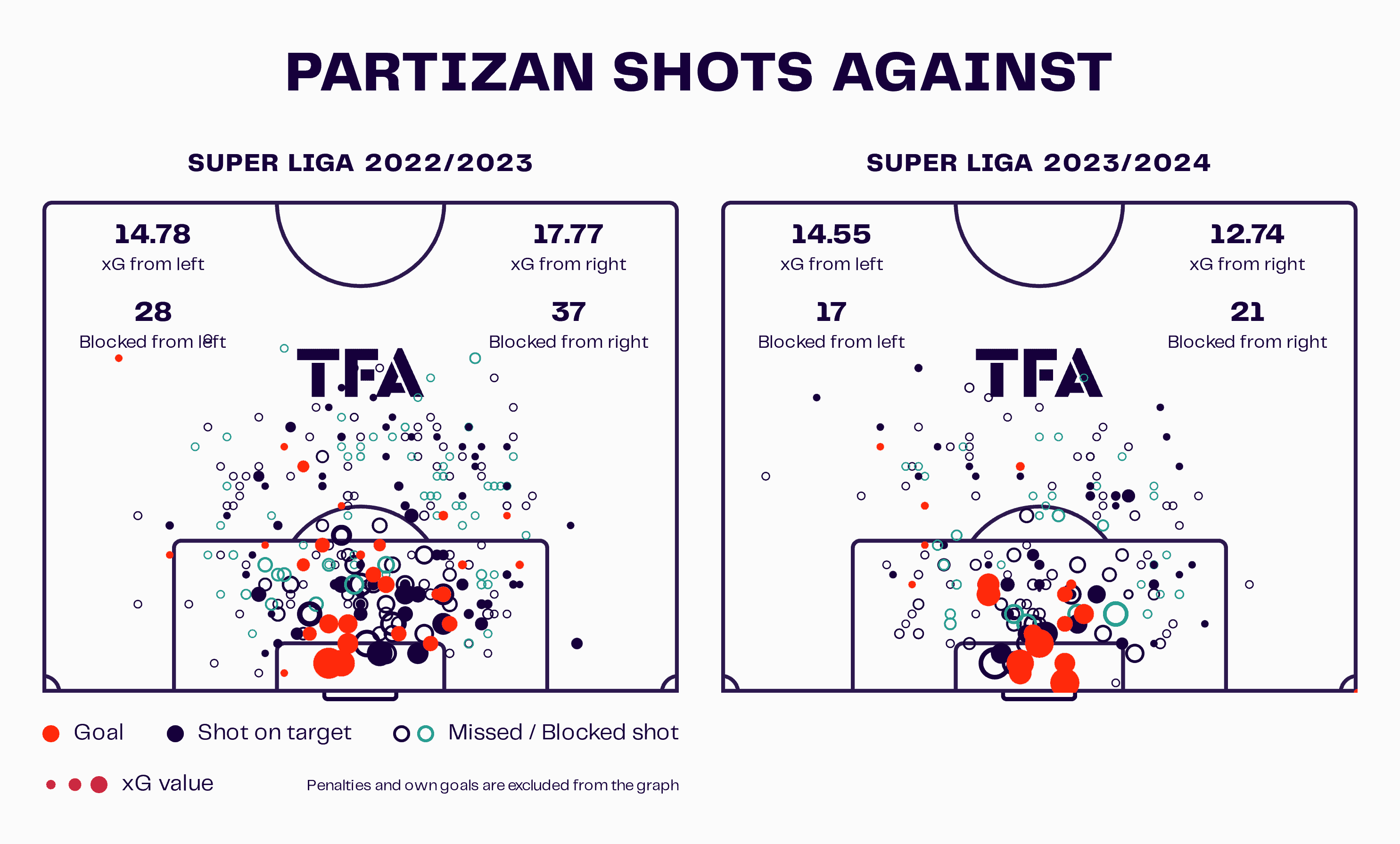
The addition of goalkeeper Aleksander Jovanovic has proven to be a pivotal factor in FK Partizan Belgrade’s defensive resurgence this season. The 32-year-old Serbian custodian, acquired for a modest fee of 450.000€ from Limassol in Cyprus, has significantly impacted Partizan’s defensive solidity. Jovanovic’s remarkable performance between the posts is reflected in his impressive record of conceding only 19 goals in 18 appearances, showcasing a level of consistency that has fortified Partizan’s backline.
With seven clean sheets to his name, Jovanovic’s shot-stopping abilities and command of the penalty area have played a crucial role in surpassing the expectations in conceding goals. Jovanovic’s shot-stopping prowess has resulted in preventing 4.2 goals, illustrating his instrumental role in Partizan’s overperformance defensively and contributing substantially to the team’s impressive standing in the league.
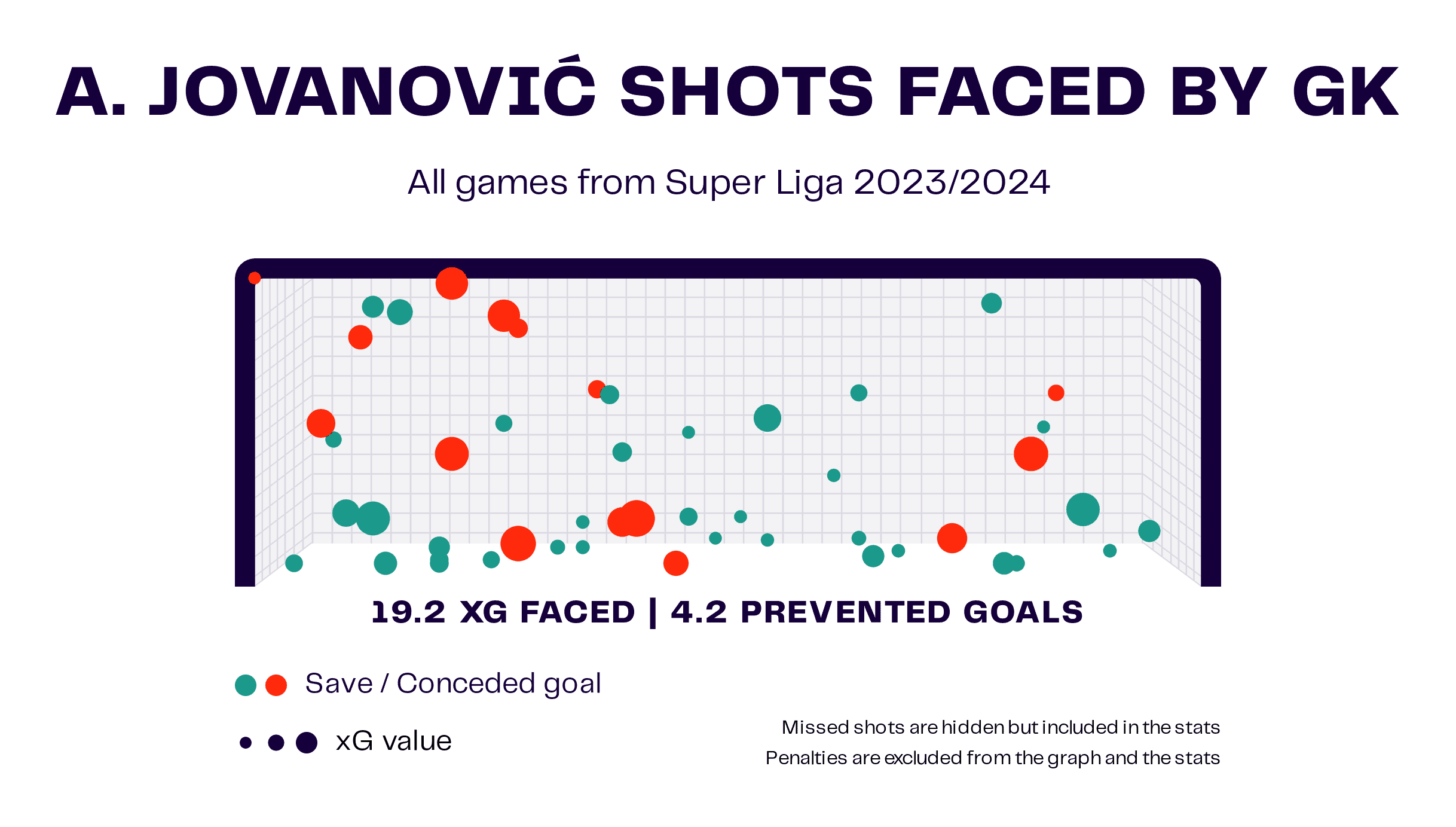
Points-wise, Partizan garnered a commendable 71 points (xPoints: 72.2) in the last season. In the current campaign, they have accumulated 47 points after 19 matches, a feat that not only places them at the summit of the league but also represents a substantial overperformance compared to the 37.80 xPoints.
The current season’s overperformance, especially when juxtaposed against the expectations set by the previous campaign, positions Partizan as a formidable force in the Super Liga Srbije, poised for a triumphant resurgence.
Build-up
FK Partizan Belgrade orchestrates a captivating transformation when in build-up play, seamlessly transitioning from a conventional 4-2-3-1 formation to a dynamic 3-2-4-1 structure. The strategic nuances unfold with one fullback holding the defensive line while the counterpart surges into the offensive midfield ranks. This tactical shift places immense responsibility on the central midfielders, intricately binding opponents and exploiting pockets of space between the lines.
Central to Partizan’s build-up philosophy is the relentless pursuit of vertical solutions. The emphasis is not merely on possession for its own sake but rather on purposeful ball circulation with a discernible intent to disrupt the opposing lines. A vital aspect of this strategy is the calculated deployment of passes that pierce both the defensive and midfield lines of the adversary, creating avenues for progressive play.
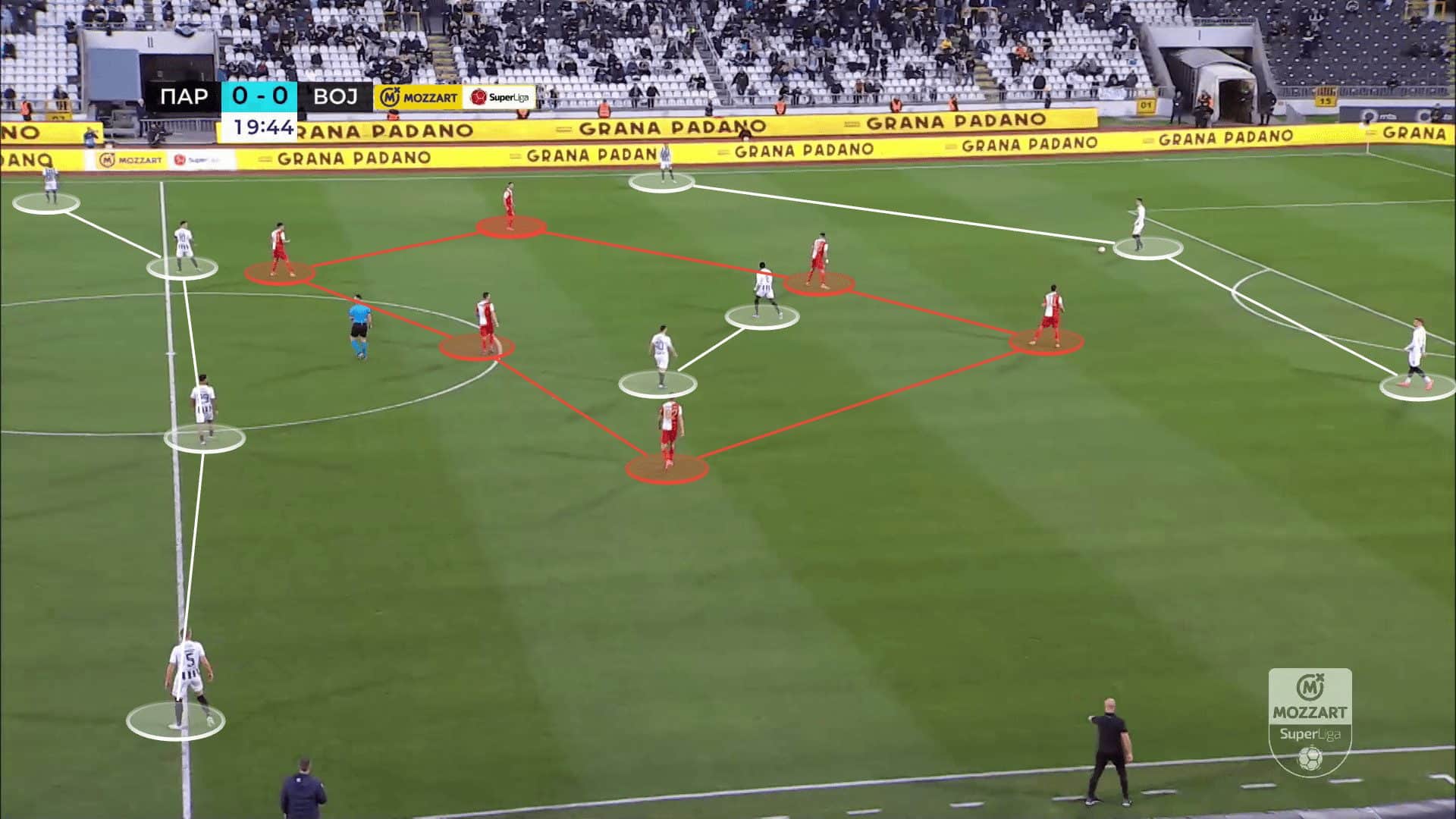
This season, a spotlight shines on the right half-space, where the seasoned campaigner Bibras Natcho emerges as a linchpin in Partizan’s intricate playmaking symphony. Natcho, displaying a mastery of both scoring and creating opportunities, has been a transformative force with seven goals and seven assists in just 19 appearances. His ability to exploit the right half-space has become a hallmark of Partizan’s offensive arsenal, offering a dimension that destabilises opposing defences and contributes significantly to the team’s attacking prowess.
While ball possession has experienced a marginal decrease from last season’s 55.5% to 54.5%, the more compelling insights lie in the passing metrics. The number of passes per 90 minutes has seen a significant reduction, dropping from 444.11 to 408.43. This suggests a more purposeful and concise approach to ball circulation, indicative of a streamlined and efficient build-up strategy orchestrated by manager Igor Duljaj.
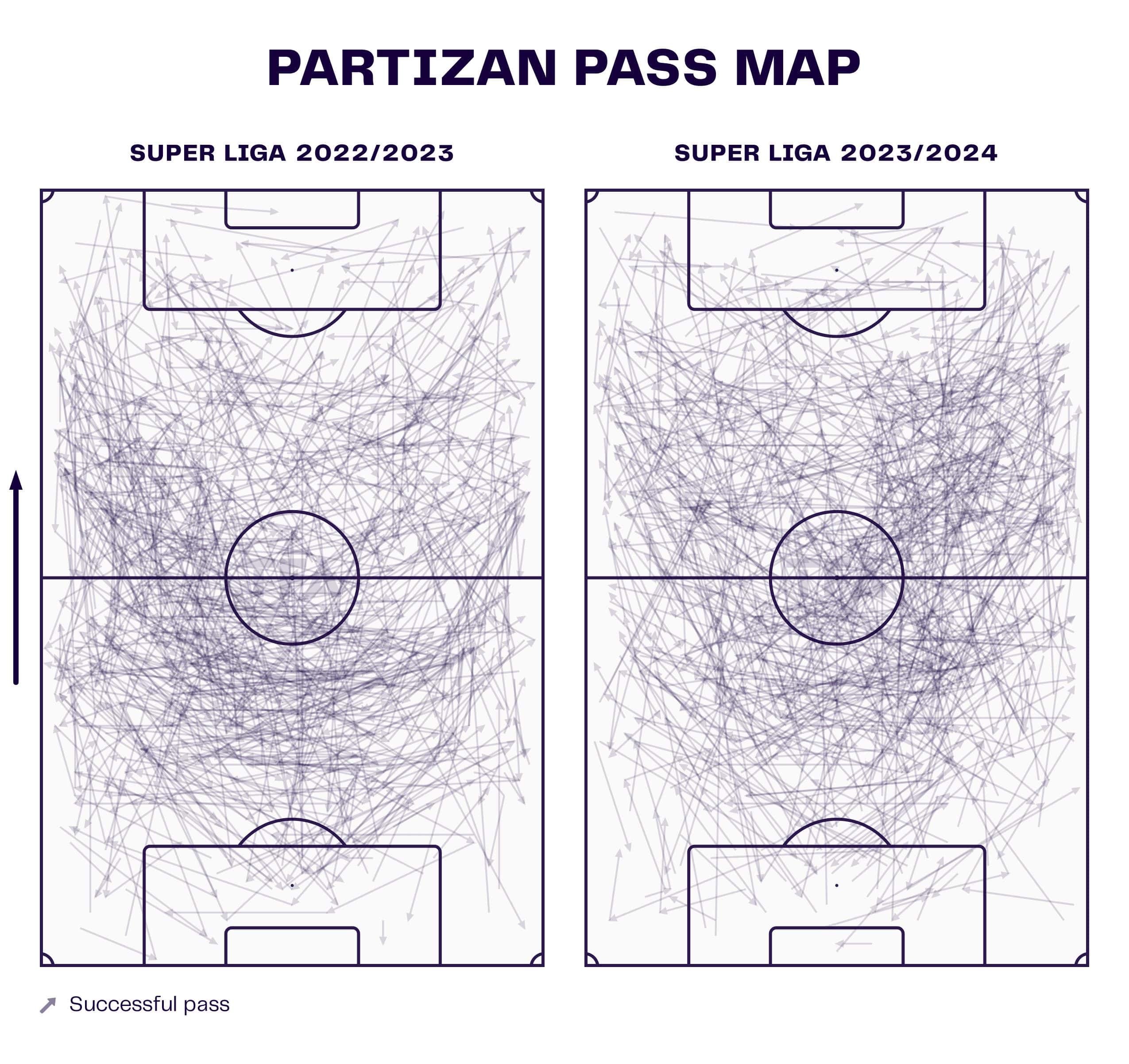
Analysing the nature of passes provides further context. The data indicates a slight reduction in long passes per 90 minutes, moving from 49.69 to 48.77. This shift implies a more controlled and measured style of play during the build-up, with an inclination towards shorter and more intricate passing sequences.
Progressive passes per 90 minutes have also experienced a slight dip, decreasing from 80.52 to 75.45. While the reduction is subtle, it suggests a nuanced adjustment in the team’s approach, potentially prioritising ball progression through calculated and strategic passes instead of a sheer volume-driven strategy.
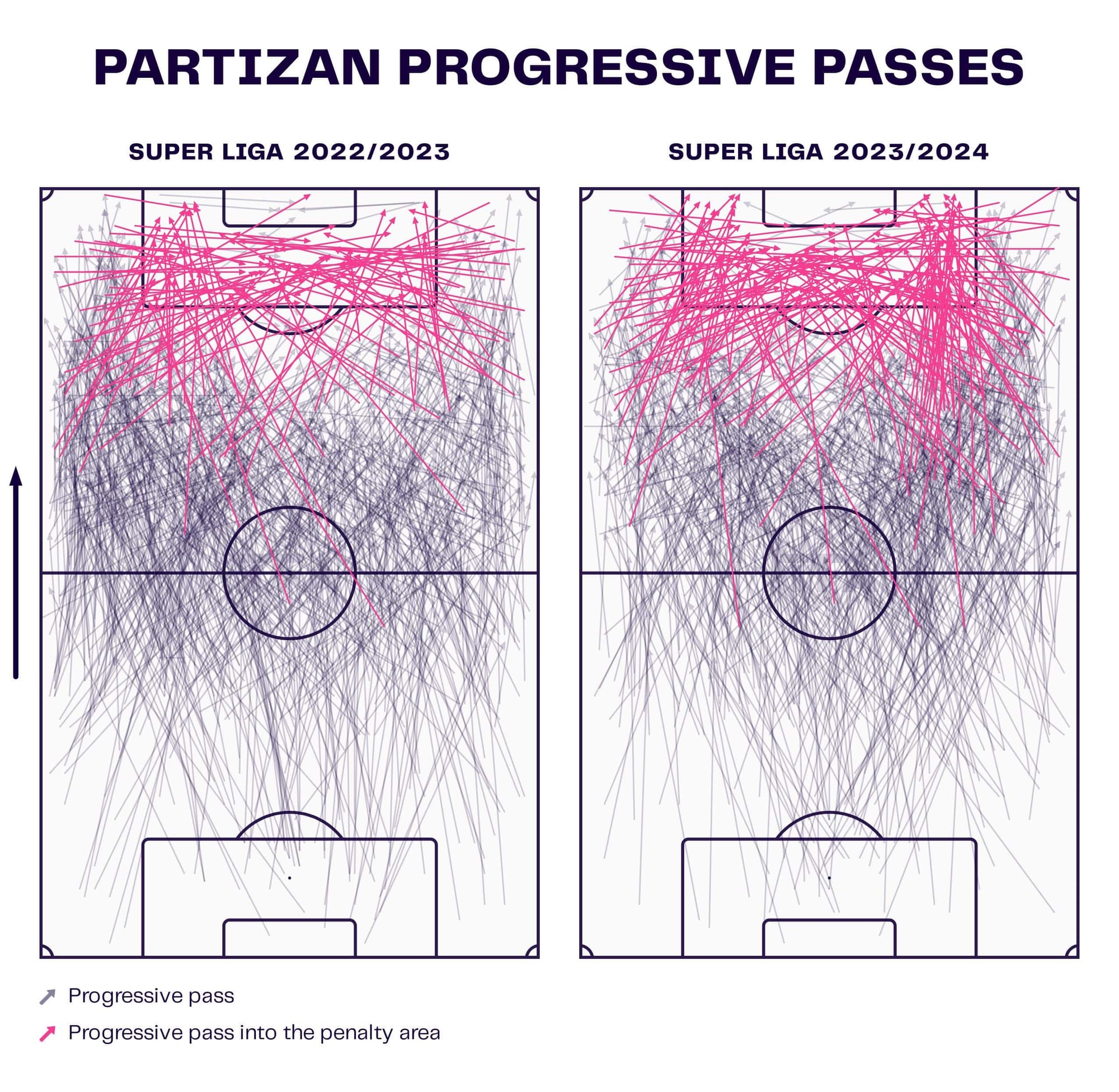
A noteworthy aspect is the defensive aspect of build-up play, as reflected in the Opposition’s Passes Allowed per Defensive Action (PPDA) against Partizan. The team has managed to decrease its PPDA against from 11.51 in the previous season to 10.67 in the current one. This indicates that they are pressed earlier, and their build-up play gets disrupted slightly more often.
Attacking Phase
The team’s propensity for dribbling has remained consistently high, with dribbles per 90 minutes increasing from 27.85 to 29.11. This suggests a continued emphasis on individual creativity and skilful play, contributing to the team’s ability to unlock defences through one-on-one situations.
Crosses per 90 minutes have also slightly increased from 14.35 to 15.87. This adjustment still ranks Partizan relatively low in the league comparison, suggesting no enhanced emphasis on wide play and aerial threats in the attacking third. Instead, they try to combine their way to the opponent’s box.
In chance creation, FK Partizan Belgrade has sculpted a distinctive identity, weaving a tapestry of intricate play characterised by short passes executed with a high frequency and a touch of precision. The orchestration begins with a mesmerising display of one or two-touch football, a rhythmic dance that permeates the midfield.
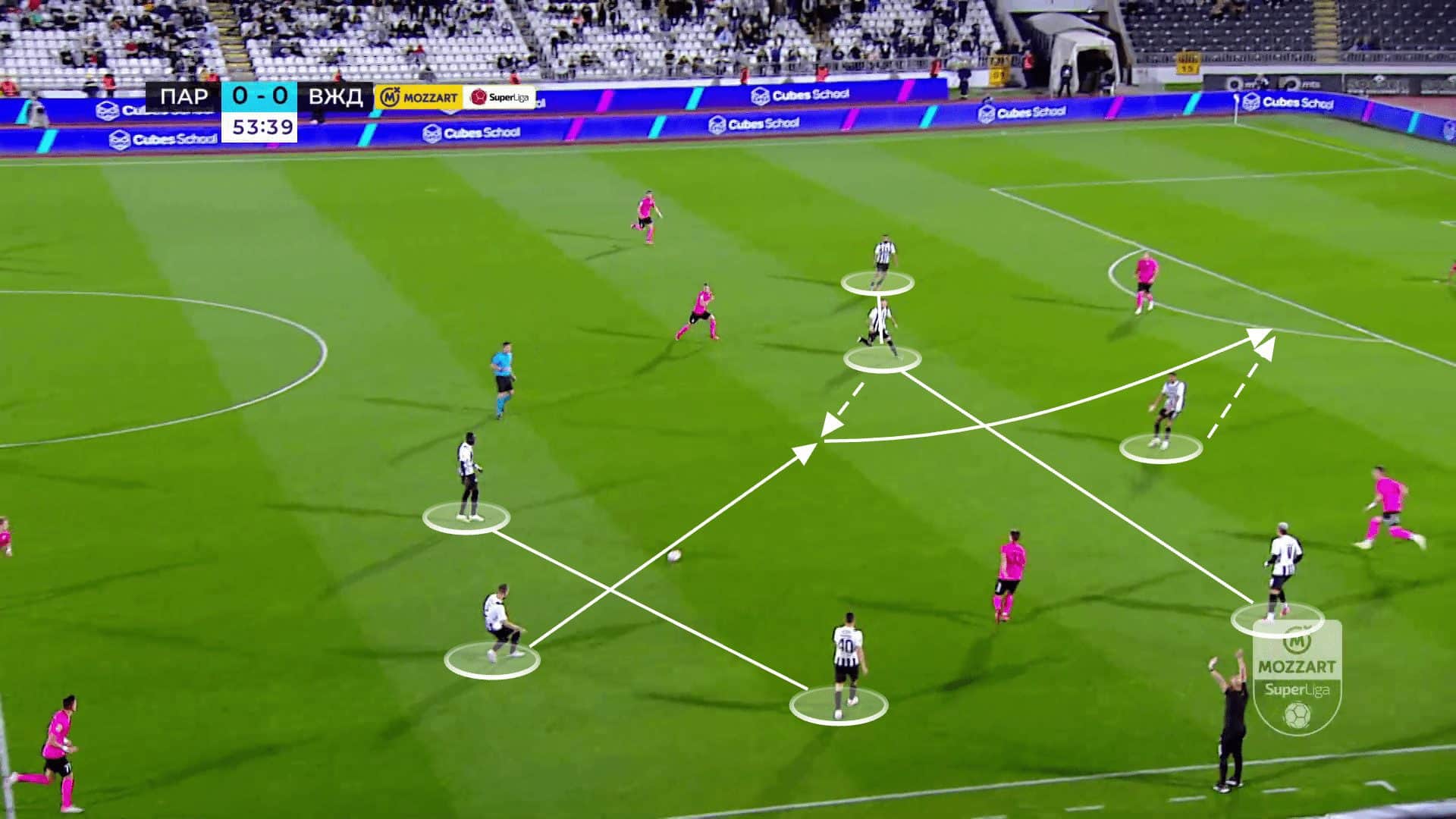
The team’s proficiency in chance creation unfolds in the attacking third, where the players seamlessly combine their efforts to navigate into the penalty box. Smart movements from wingers and the centre forward unravel the opposing defences—the players’ ability to read the unfolding play, making incisive runs and positioning themselves intelligently. A distinctive feature in Partizan’s chance creation playbook is the deployment of through passes to break the defensive line.
The passing metrics in advanced areas provide further insights into the team’s attacking evolution. Through passes per 90 minutes have increased from 6.24 to 7.35, indicating a more incisive and penetrative style of passing that seeks to break defensive lines. Key passes per 90 minutes have seen a marginal uptick from 3.77 to 3.94, suggesting sustained creativity in the final third.
Passes to the final third per 90 minutes have increased from 59.40 to 61.87, highlighting an enhanced ability to progress the ball into advanced attacking areas. Smart passes per 90 minutes have remained relatively stable, showcasing a consistent level of intelligent and strategic passing play.
In terms of shooting, there has been a notable increase in the number of shots per 90 minutes, rising from 13.81 to 15.62. This uptick may indicate a more proactive and assertive attacking approach, resulting in a higher volume of attempts on goal.
Defensive Phase
The defensive phase of FK Partizan Belgrade has undergone a discernible transformation from the 2022/23 season to the current 2023/24 campaign.
Examining ball losses per 90 minutes reveals a slight reduction from 109.54 in the previous season to 105.72 in the current one. While the decrease is modest, it suggests a concerted effort to minimise turnovers, showcasing an enhanced focus on ball retention and stability.
Therefore, the defensive duels per 90 minutes have experienced a more significant decrease, moving from 67.30 to 59.29. This suggests a strategic adjustment in defensive positioning and decision-making, indicating a more organised defensive structure that minimises the need for frequent one-on-one defensive duels.
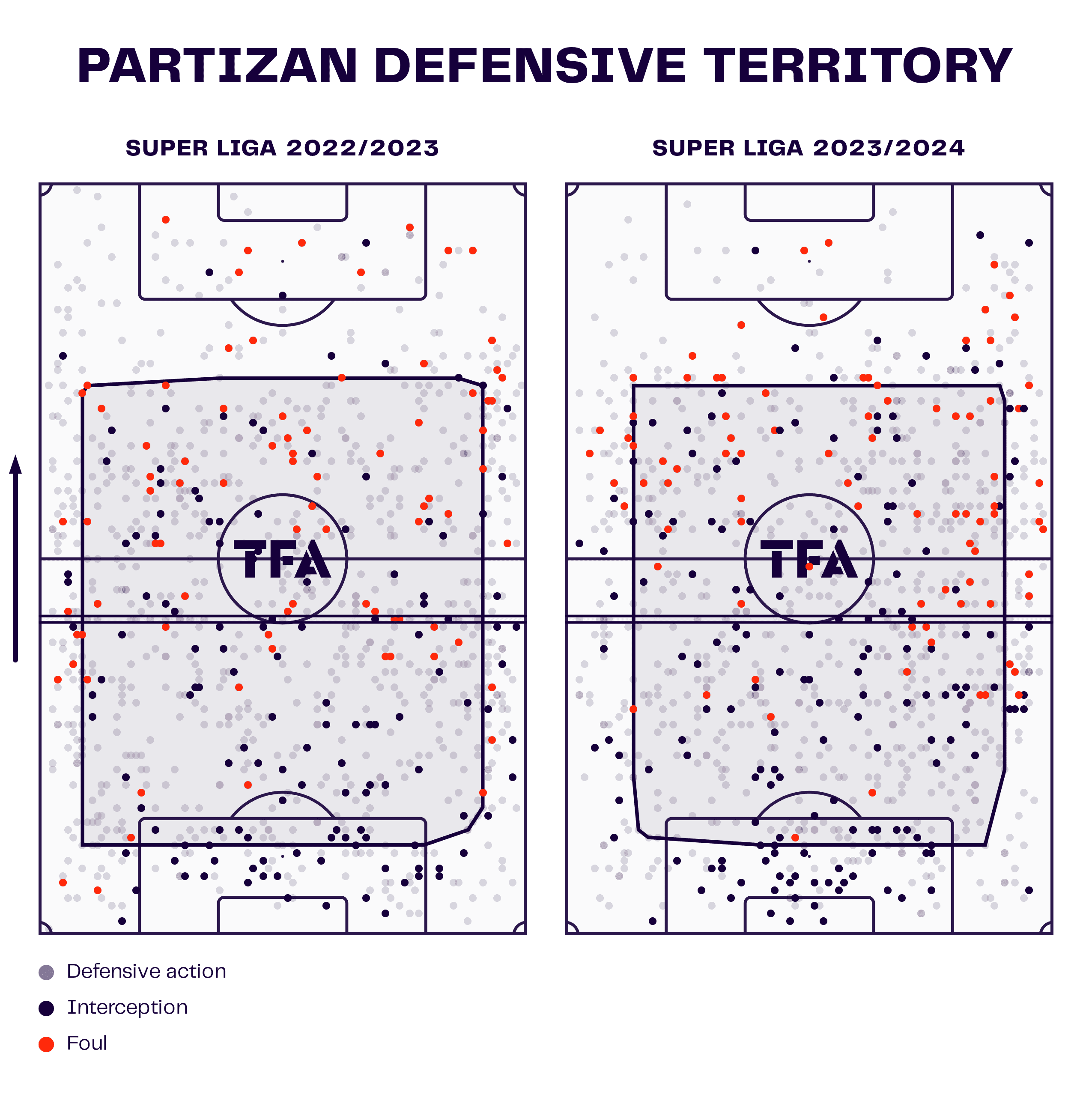
The challenge intensity metric, which gauges the intensity of defensive duels, interceptions and tackles, has decreased from 6.50 to 6.10. The decrease in challenge intensity aligns with the team’s objective of maintaining defensive solidity with a measured and controlled defensive style.
The Passes Allowed per Defensive Action (PPDA) metric provides further context to Partizan’s defensive evolution. The team has managed to reduce their PPDA from 7.66 in the previous season to 7.40 in the current one – a similar value to that of Jürgen Klopp‘s FC Liverpool. A lower PPDA signifies a more effective and coordinated pressing strategy, indicating an enhanced ability to disrupt opponents’ build-up play and regain possession in advanced areas.
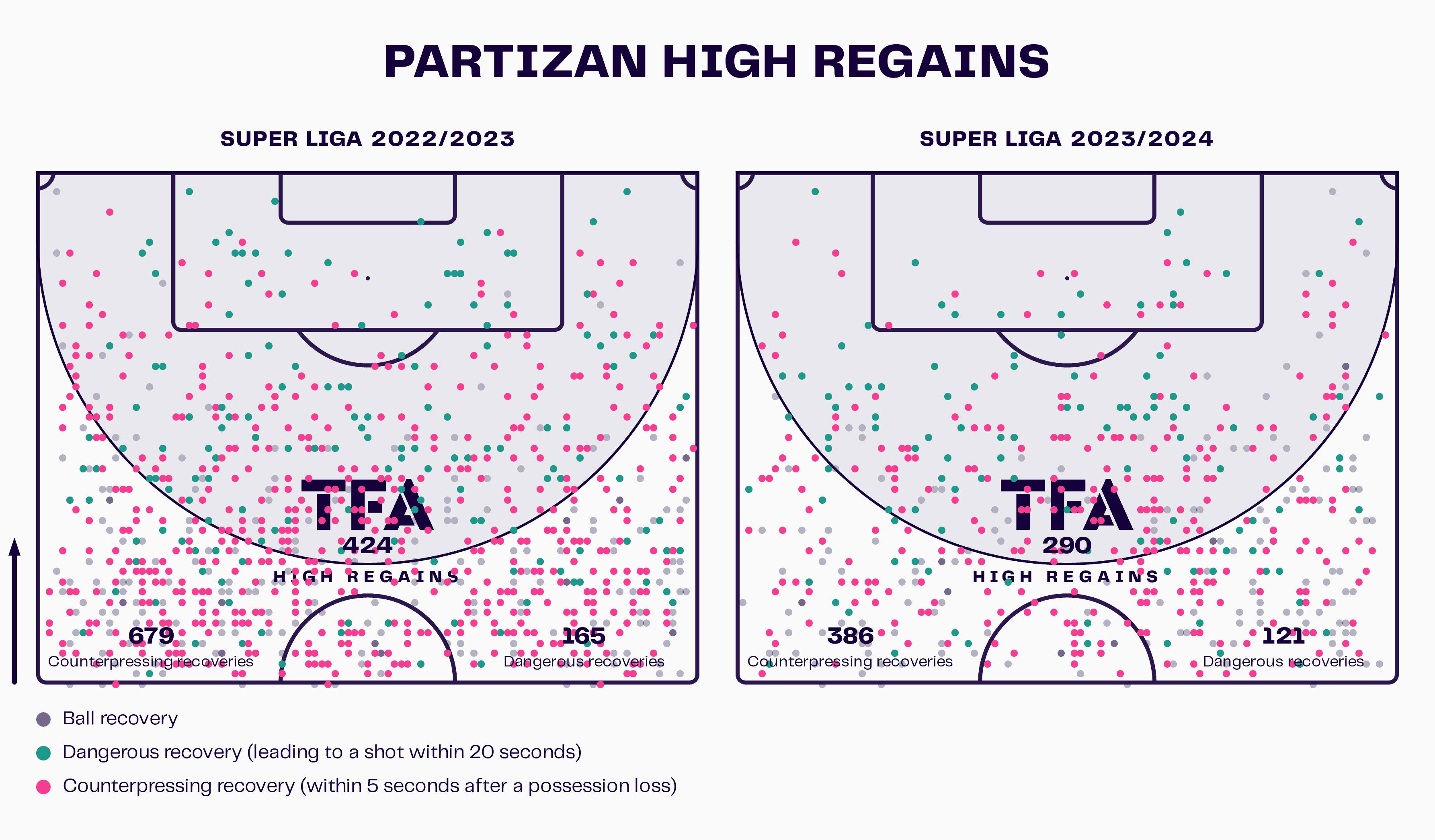
The tactics during defensive transitions see a seamless transformation from a base 4-2-3-1 formation to a dynamic 4-3-3. This shift is marked by the wingers pushing up alongside the centre-forward, effectively forming a compact trio at the forefront to block passing lanes and limit the opposing fullbacks’ influence in the attacking build-up. This strategic adjustment not only disrupts the opponent’s initial ball circulation but also puts pressure on the defensive structure by closing down spaces and forcing hurried decisions.
The central midfielders play a pivotal role in maintaining compactness. Forming a triangle, these midfield architects act as a cohesive unit, ensuring a disciplined and synchronised defensive approach. This triangular structure not only stifles the opposition’s attempts to play through the centre but also provides a foundation for coordinated pressing and interceptions.
To further enhance defensive solidity, Partizan’s defensive line executes a coordinated push up the pitch. By avoiding large distances between the lines, the team minimises the spaces that opponents can exploit. This cohesive defensive line not only restricts the opponent’s options but also enables Partizan to dictate the tempo of the game by pushing the engagement zone higher up the field.
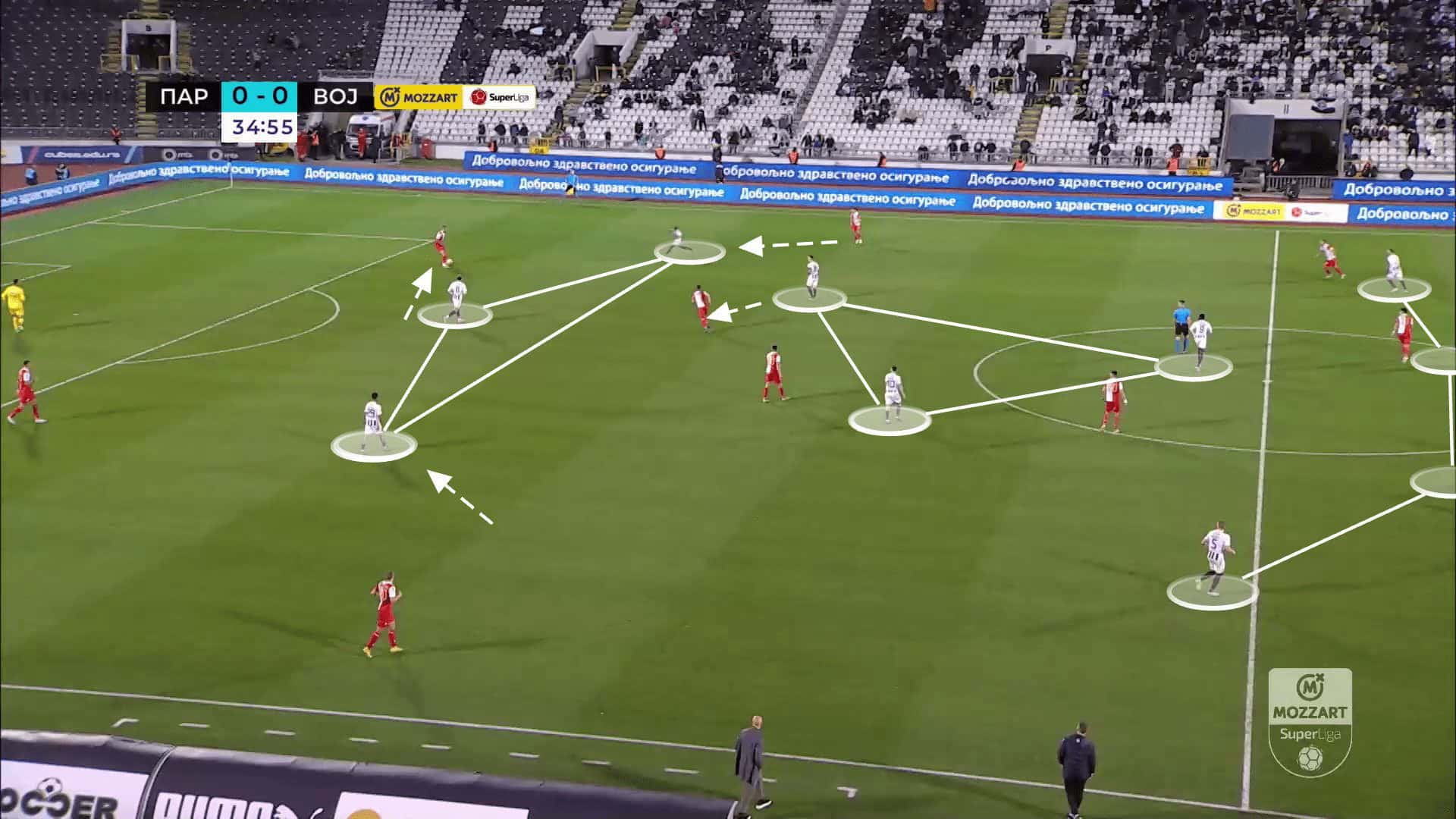
The defensive phase of FK Partizan Belgrade has undergone a refinement under Igor Duljaj’s management. The reduction in ball losses and a lower PPDA reflect a more organised, controlled and aggressive defensive approach. This strategic adjustment minimises defensive vulnerabilities and initiates effective pressing and counter-pressing sequences.
Conclusion
FK Partizan Belgrade’s current campaign in the Super Liga Srbije stands as a testament to the resounding success of manager Igor Duljaj’s tactical overhaul and strategic vision. The team’s remarkable ascent to the top of the league table, and therefore for a UEFA Champions League spot, has been a narrative despite facing financial disparities with arch-rivals Red Star Belgrade.
The remaining matches will undoubtedly offer further insights into the sustainability of their outstanding form, but for now, Partizan’s resurgence is a testament to the transformative impact of strategic leadership and collective determination.





Comments